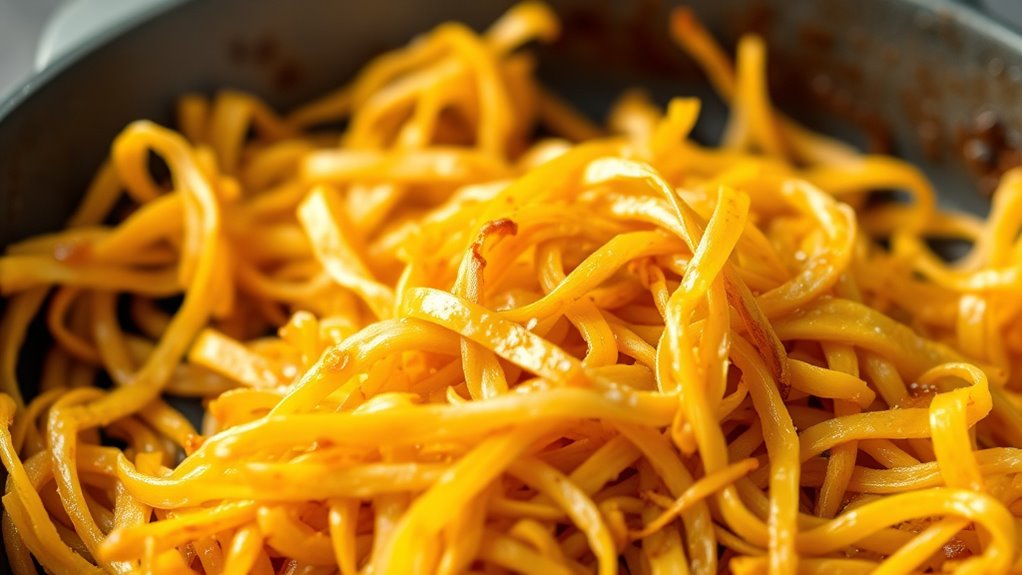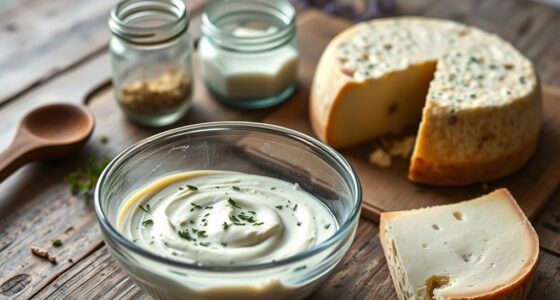When cooking with jackfruit, its fibrous structure pulls apart into strands that resemble shredded meat, making it a great plant-based alternative. This texture mimics real meat thanks to its unique fiber makeup, which easily absorbs flavors from spices, sauces, and marinades. Proper preparation and cooking reveal its meat-like consistency, perfect for various dishes like tacos, curries, or BBQ. Keep exploring to discover how to maximize its texture and flavor in your meals.
Key Takeaways
- Jackfruit’s fibrous flesh pulls apart into strands resembling shredded meat, creating a meat-like texture when cooked properly.
- Proper cooking and seasoning allow jackfruit to absorb flavors, enhancing its meat-mimicking fiber structure.
- Rinsing canned jackfruit removes brine, preparing it to better mimic the texture and taste of shredded meat.
- Understanding its fiber structure helps in adapting recipes for pulled pork, tacos, or curries with a meat-like consistency.
- Cooking techniques such as sautéing, simmering, or roasting help break down the fiber, achieving a more realistic shredded meat appearance.

Cooking with jackfruit opens up a world of delicious, plant-based possibilities that can satisfy any craving. One of the most exciting aspects of this versatile fruit is its unique fiber structure, which mimics the texture of meat remarkably well. This makes jackfruit an excellent choice if you’re looking to incorporate more plant-based protein into your diet or want to experiment with dishes traditionally made with meat. When cooked properly, the fibrous flesh of young green jackfruit pulls apart into strands that resemble shredded meat, giving your dishes a satisfying, hearty bite without any animal products.
Because of its meat-like texture, jackfruit is celebrated for its culinary versatility. You can use it to create everything from pulled pork sandwiches to tacos, curries, and even BBQ dishes. Its ability to absorb flavors makes it a perfect vehicle for spices, sauces, and marinades, allowing you to customize dishes to your taste. Whether you’re aiming for smoky, spicy, or tangy profiles, jackfruit adapts seamlessly, ensuring each dish offers a rich, satisfying experience. This adaptability makes it a favorite among vegans, vegetarians, and anyone interested in reducing their meat consumption without sacrificing taste or texture.
What truly sets jackfruit apart is its role as a plant-based protein source. While it isn’t as protein-dense as legumes or soy, it offers a substantial amount of dietary fiber and some protein, contributing to a balanced plant-based diet. It’s especially valuable if you’re seeking to diversify your sources of plant-based protein, as it provides a satisfying alternative that doesn’t compromise on texture. Plus, since it’s naturally low in calories and fat, it’s an excellent addition to healthy meals, giving you the feeling of fullness and satisfaction without excess calories.
Using jackfruit in your cooking is straightforward. You’ll typically find it canned in brine or water, which you drain and rinse before preparing. To achieve that shredded, meat-like consistency, you cook it with spices and sauces, allowing the fibers to absorb the flavors. The result is a dish that looks and feels like traditional meat but is entirely plant-based. Its fiber structure is the secret behind its ability to mimic meat, making it an essential ingredient for plant-based cooking. Understanding the fiber structure of jackfruit can help you better manipulate its texture to suit different recipes. This knowledge is similar to how car brands are tuned for performance, allowing cooks to customize dishes to their preferences. Another interesting point is that cultural adaptations of jackfruit dishes can add unique flavors and styles to your cooking. With a little experimentation, you’ll discover how this tropical fruit can transform your meals into hearty, flavorful, and satisfying dishes that cater to both your taste buds and your health goals.
Frequently Asked Questions
Can Jackfruit Be Used in Desserts or Sweet Dishes?
You might wonder if jackfruit can be used in desserts or sweet dishes. The answer is yes—sweet jackfruit works beautifully in dessert recipes. Its natural sweetness and tender texture make it perfect for smoothies, puddings, or fruit salads. You can also caramelize or blend it into jams. Incorporating sweet jackfruit adds unique flavor and texture, making your dessert recipes more exciting and nutritious. Give it a try in your next sweet creation!
How Do Different Cooking Methods Affect Jackfruit’s Texture?
Imagine a chameleon changing colors—your jackfruit transforms with each cooking method. Boiling keeps it moist, preserving its tender, fibrous texture, while roasting or grilling introduces a smoky, firmer bite. Frying crisps the exterior, creating a contrast that enhances its meat-like quality. Different techniques drive texture transformation, impacting moisture retention and mouthfeel. So, you control the experience, tailoring jackfruit to suit your dish and desired texture.
Is Canned Jackfruit Suitable for All Recipes?
Canned jackfruit offers great versatility, making it suitable for many recipes, but it might not fit all. While fresh jackfruit has a firmer texture and more flavor, canned options are convenient and readily available. You should consider the recipe’s requirements—canned jackfruit works well for shredded dishes and vegan meats, but for recipes needing a firmer or fresher taste, fresh jackfruit might be better.
What Are the Best Spices to Enhance Jackfruit’s Flavor?
Imagine transforming a blank canvas into a masterpiece—that’s what the right spices do for jackfruit. To enhance its flavor, try spice pairing with cumin, smoked paprika, chili powder, and garlic. These flavor enhancers add depth and smokiness, making your dish more savory. A pinch of salt and a squeeze of lime also brighten the flavors. Experiment with these options to find your perfect combination, turning simple jackfruit into a flavorful favorite.
How Long Does Cooked Jackfruit Stay Fresh in the Refrigerator?
When you store cooked jackfruit in the refrigerator, it stays fresh for about 3 to 4 days. Be sure to check for spoilage signs like a sour smell, slimy texture, or discoloration. Proper storage duration helps prevent spoilage, so keep it in an airtight container. If you notice any signs of spoilage, it’s best to discard it to avoid foodborne illness.
Conclusion
Cooking with jackfruit lets you enjoy a versatile, nutritious, and satisfying meat alternative. It provides a fiber structure that mimics meat, making every dish delicious and hearty. Whether you’re craving tacos, sandwiches, or stir-fries, jackfruit adapts to your flavor, your style, your needs. Embrace its texture, embrace its health benefits, embrace the endless possibilities. With jackfruit, you can cook, experiment, and enjoy—creating meals that are nourishing, flavorful, and entirely your own.










